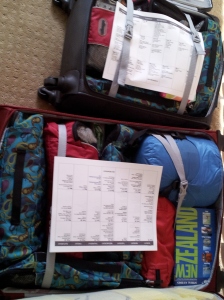
Our existing IT roll aboard which is 22 inches high including wheels and handles. Our new handbag and laptop bag which meet the Lufthansa size requirements, including being only 4 inches deep.
We encountered a new wrinkle in carry-on regulations on our last trip to Morocco on Lufthansa Airlines. As we walked down the jet way in Casablanca, the line stopped. There were several people with baby strollers and wheel chairs ahead of us, so I just figured we were backed up while these items were gate checked.
When we finally got to the choke point, there were two Lufthansa employees surrounded by a sea of carry-on bags all with checked baggage tags on them. I walked past with my small roll aboard and overstuffed Rick Steve’s Day bag backpack, but my husband was stopped. He had our second roll aboard and his Rick Steve’s Day bag. All of our tickets had the words “One carry-on bag” printed on them.
They told my husband that he had to check his roll aboard bag, and pointed at me and my carry-on and backpack. My husband said fine, “You can gate check this”, but these were not being gate checked, they were being checked through to the baggage claim. I reminded him that if he was going to check his roll aboard he needed to remove his laptop.
At this point one of the agents let us go ahead, although the second agent appeared annoyed with this decision. I was completely confused. Don’t we get “one carry-on AND one personal item.” I knew that Lufthansa limits the weight of carry-on luggage, so we had ensured that our roll aboard bags were within the size and weight limits (8 kg (17.6 lbs)).
When I got home I looked up Lufthansa’s website and their carry-on restrictions. Indeed our roll aboards were within the size and weight limits. I believe the problem was with our “one personal item”. According to Lufthansa’s web site: “Also allowed in the cabin: another item of carry-on baggage (max. 30 x 40 x 10 cm, e.g. handbag, laptop bag), one baby carrier per child or a child’s car seat or a foldable pushchair/buggy (may have to be transported in the cargo hold) and wheelchairs/orthopaedic aids (e.g. walking aids).” I believe that our Rick Steve’s backpacks exceeded the size limits of 11.8 in x 15.7 in x 3.9 in. Both of our Rick Steve’s bags fit fine under the seat in front of us in Economy, even though the space was limited by the newly installed electric outlet boxes under the seats.
I had also thought that when you fly internationally the flight with the longest distance takes precedence on luggage limits. This would have put us under United’s limits. Turns out that the longest flight only applies to checked baggage, not carry-on.
We will be flying on Lufthansa again in 2016, this time in Business class which Lufthansa allows you two pieces of larger carry-on luggage, plus the small item. To be on the safe side I have bought myself a new handbag and my husband a new laptop bag that both meet the “Also allowed in cabin” size restrictions.
I think this all has to do with a new fare structure implemented by Lufthansa for flights after October 1, 2015, but I am only guessing at this point. This new fare structure allows a lower fare for people with little or no baggage. http://www.lufthansa.com/online/portal/lh/us/informationservice/flightinfo?nodeid=1723952809&l=en










